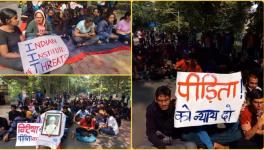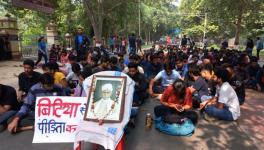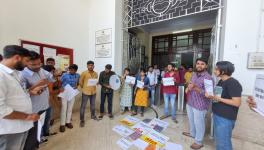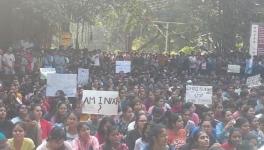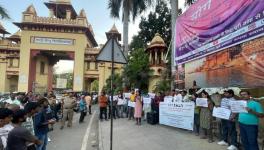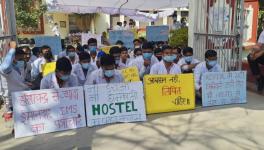Ground Report: Munshi Premchand’s Legacy Infested by Termites
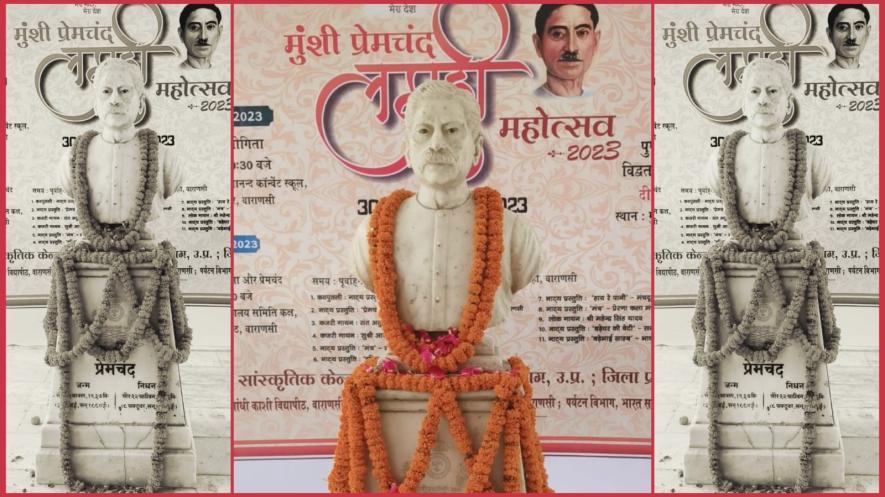
The birth anniversary event on July 31
Varanasi: To celebrate the 134th birth anniversary of progressive writer Munshi Premchand, who brought poverty, exploitation and injustice to life in his literary works, the locked doors of his meeting room were opened during Lamhi Mahotsav in his village Lamhi.
The rooms are in a dilapidated state, with window and door frames crumbling due to termite infestation.
Some voluntary organisations organised a play and lamp lighting ceremony on the occasion of Lamhi Mahotsav. Some school children, designated Premchand Mitr, also participated in the programme. These students were given T-shirts and letters of appreciation. Officers of the Uttar Pradesh culture and tourism department and some literary personalities also attended the event.
Well-known journalist Yogesh Sharma from Varanasi, who has waged a long struggle to preserve the legacy of Munshi Premchand, was aghast at the poor state of the memorial.
In a conversation with Newsclick he said, “Premchand was an artist who understood humans and their psychology. We saw what a spectacle was going on at Lamhi. On the other side, newspapers are consistently publishing reports of how Premchand is being ousted from the curricula. My heart melted and so I went to Lamhi. I thought that if Premchand’s ideas, his stories and his novels won’t remain, then what is the point of his memorial?”
He said, “Some things were bothering me. In 1959, Dr. Rajendra Prasad visited Lamhi. A stone was installed in his name, which couldn’t be found anywhere now. There was another stone of the Bangiya Sahitya Parishad, which too was missing. If you ever visit and try to remove the overgrown bushes, you will find that some of the inscriptions commemorating Premchand are also nowhere to be found.His dilapidated meeting room and the locked doors of the research institute opened in his name, brings us intense heartache.”
On the occasion of great storyteller Premchand’s birth anniversary, the roads from Pandeypur to Lamhi appeared a bit clean for the first time. The Pandeypur intersection has also been given Premchand’s name. A statue of Premchand has been erected under a flyover pillar on top of which hoardings of a builder and Lions Society can be seen.
Underneath the statue, Premchand’s name, his birth date July 31, 1880, and his death anniversary October 8, 1936 are inscribed. The statue of the great writer appeared to be slightly cleaner for a change, however, the muck gathered above pointed to the fact that the cleaning must have taken place after many months. This too seems to have been done in a ritualistic manner.
Around the statue, balua stones have been placed on which the title of Premchand’s stories are inscribed. Several posters like missing person announcements etc are strewn all across this site. These posters affirm that the government’s machinery is utterly disinterested in the great writer. Everything seemed drab and melancholic here.
No one cares about Katha Samrat
The great novelist Munshi Premchand’s village Lamhi is 7 km away from Varanasi’s district headquarters. A huge gate can be seen from a distance on Varanasi-Azamgarh Marg, on which the inscription Munshi Premchand Smriti Dwar can be seen. The two bulls installed on both sides of the doorway remind us of Heera and Moti. The figurine of the farmer with a plough takes us back to Munshi Premchand’s landmark novel Godan’s protagonist Hori.
Even on his birth anniversary, this doorway and the pair of bulls hadn’t been cleaned. A long hoarding of Hanuman ji was seen across this doorway on which the slogan ‘Har Har Mahadev’ was written. A coaching centre’s hoarding was hanging from a pole. Beneath the two hoardings, a banner by the culture department indicated that Lamhi Mahotrsav would be organised in the name of Munshi Premchand.
A young man passing through Premchand Dwar spoke in a harsh tone, “The Modi-Yogi government that spent money like water in the name of G-20 must have forgotten the great writer Premchand’s birth anniversary. On this day the representatives of culture and tourism departments can be seen zooming in the area with their cars.”
As one enters the Munshi Premchand Smriti Dwar, it doesn’t seem like Lamhi was the village of the great storyteller who produced timeless masterpieces like Godan, Thakur ka Kuan, Eidgaah, Do Bailon ki Katha, Sava Ser Gehoon, Gaban etc.
The research institute’s lock was not even opened for the birth anniversary event
Lamhi is only a village name now. Perhaps, it is only alive in government documents. Upon entering from the main road and passing the pucca road to enter the village, the mashup of electricity wires tells a clear story. Previously, Lamhi village used to elect a village pradhan (head), however now the locals elect a sabhasad. In this village, the Varanasi Development Authority is responsible for the upkeep of Munshiji’s memorial and building of roads etc. The window through which Premchand once gazed at his village, now opens to a view of a concrete forest. Several multi-storeyed buildings weigh down upon Lamhi’s landscape.
Moving ahead of Premchand Dwar, the road is dotted with vegetable shops on both sides where hundreds of farmers gather every day to sell and buy their produce. The heavy crowd in the market was completely unaware about any programme being organised in Lamhi in Munshi Premchand’s memory. People simply knew that the roads that had been full of garbage and dirt for years seemed to have been cleaned today.
We met one Shivnath Prasad in Lamhi. He reminisced about the old days and said, “There was a time when the village’s older people gathered at Ramlila Maidan every evening. They used to share each other’s happiness and sorrows, but now no one cares about others. No swings are set up in the village and no drama troupes perform any plays anymore. Only dangling electric wires can be seen now. Lamhi doesn’t have bhadbhuje (the community traditionally involved in roasting gram) anymore. We have to travel outside the village to get grains roasted.”
“This is the picture of Lamhi where a great pioneer of Hindi literature beautifully captured social realities by depicting the struggles of village life and the plight of the farmers. The reality is that the village itself is lost in Lamhi now,” he said.
The research institute lock remained unopened!
A large hoarding can be seen as one approaches Premchand Memorial on which “Munshi Premchand Research and Study Centre, Kashi Hindu Vishwavidyalaya, Varanasi” is inscribed in English and Hindi. The centre was found locked from inside. Upon continuously knocking, a caretaker opened the gate. He refused to divulge his name and said, “We have been instructed to keep the research centre’s gate closed, no matter whose birth anniversary it is. We won’t open the lock on anyone’s request as long as we don’t have orders from above. This is why the cleaning of the institute’s rooms and the pruning of the trees and shrubs cannot take place. I cannot answer your questions. You should contact BHU’s Hindi Department. We have been ordered not to speak anything.”
On rainy days, dirty water rips down on Munshi Premchand’s statue in Pandeypur
On Premchand’s birth anniversary, many people from UP and Bihar, who are interested in literature, reached Lamhi. However, none of the Hindi scholars from Banaras Hindu University or BHU were present at the event. The people who claimed to make this research centre an important national institute only a few years ago, seem to have forgotten the great writer.
The Research Centre in Lamhi that lies deserted was opened when late Mulayam Singh’s government allocated Rs 5 crore to set it up. The purpose of opening the centre was to hold literary discussions and research activities. However, the situation now tells a different story. The centre is filled with dirt and cobwebs.
Some Lamhi residents say, “The empty rooms of the research centre are decaying. In the name of a museum, merely Munshi ji’s broken slippers, clothes and some belongings can be found there. The books in the library are in such a condition that pages start falling out if one picks them.”
The responsibility of the Munshi Premchand Research Centre lies with Kashi Hindu Vishwavidyalay’s (BHU) Hindi department. However, no research work has ever been carried out in it so far. Approximately Rs 2 crore were sent on the construction work of this centre in 2016. The purpose of opening this institute was to carry out academic work, research work, organising seminars, and discussions etc to promote Hindi literature. After the inauguration, everyone seemingly forgot this.
The head of the Munshi Premchand Research Centre is the head of BHU’S hindi department, who is a professor of both Hindi and Urdu. The Hindi scholars of BHU are being levelled with accusations that they are sinking the boat of Premchand’s legacy. No single essay-writing, story-writing, drawing competition has been held at the centre. Not a single book has been added in the past six years. The books that are present at the centre are mostly donations.
Books and memoirs kept in the Premchand Memorial
Disregard of legacy
Lamhi seems cleaner as compared to other villages. The Premchand Sarovar is in the middle of the village but is filled with filth. The locals say that some people have also redirected their drains into the pond. Right next to the pond is Premchand’s ancestral home. The house has taken the form of Premchand’s memorial. There is a statue of Premchand in the memorial. There are two rooms on the left in which a small library has been set up. Munshi Premchand’s literary creations are also kept in the library.
The chimta (tongs) hanging on the wall makes one realise that everyone must have read Premchand’s story Eidgaah, albeit in the school curriculum. The protagonist of the story is a little boy Hamid who unlike his friends does not fall into the desire for toys and dolls and instead buys a chimta for his grandmother from the fair. But why just the chimta? It’s because his grandmother’s hands got burnt making rotis. Through this short story, Premchand says big things through the little boy Hamid’s character.
In Premchand’s memorial, a pair of gulli-danda can be seen hanging next to the chimta on the wall. The manager of the library Suresh Chandra Shukla says, “Litterateurs from all over North India come here every day, which includes women and children.”
Right next to the library is the same meeting room of Premchand which is being eaten away by termites. Premchand used to do his reading and writing work in the uppermost room of this structure. A kitchen was set up in the lower section of the house. This is where the arrangements of guests were made. There are two courtyards in this three-storey house. A staircase from the courtyard leads to the first and the second floor. There are two rooms on the uppermost section of the house in which Munshiji created some of his timeless literary creations. There is a dried-up well on the western side of the house. It has been closed with an iron cover. The memorial was made in his house after the intervention of literary figures from Banaras, however apart from two small rooms nothing remains preserved anymore. No tourists or writers ever visit this place. In such a situation, who will be held responsible for preserving its legacy?
When apprised about the poor state of the memorial, the manager of the local cultural centre, Subhash Yadav, said, “The house is the property of the writer’s family and their permission is required for carrying out any restoration work. We wanted to make a great museum for Munshi Premchand. This accusation is false that we don’t carry out cleaning of the rooms. Readings of Premchand’s work are held here every day. To promote children’s interest in literature, a painting competition based on Munshi Premchand’s life was organised along with a march. Many colleges have been named Premchand Mitr. Schoolchildren are being taught Hindi essays and creative writings here.”
Durga Prasad Srivastava, who has been running a campaign to preserve Premchand’s legacy for decades, refutes Yadav’s claims. “When their thinking isn’t right, how will they develop Lamhi? The Cultural Department Official must first honestly answer the question of Banaras’s writers that how much money of the taxpayer has been spent so far in Premchand’s name? How much has their department transformed Lamhi? The truth is that no one is concerned about Lamhi. … The bureaucrats remember Munshiji only when the government sends them a large sum for organising Lamhi Mahotsav,” he said.
It was late President Rajendra Prasad who laid the foundation stone of the Premchand memorial on October 8,1959. At the time, Sampurnanand was UP’s Chief Minister. At the time, this memorial was under the Nagari Pracharini Sabha. There used to be a thatched house in its place which later collapsed. A portion of the house was donated to Nagari Pracharini Sabha, which invited the then President. The memorial has existed since then. The memorial was locked for a few years and that space got filled with grass, bushes and garbage.
Senior journalists in Varanasi, S. Atibal, Yogendra Sharma, Sushil Tripathi and others like Laxmi Prasad Mishr, Kashinath Singh, Tribhuvan Singh, Mohanlal, Prahlad Tiwari, Manvi Sharan etc then began a campaign to free the memorial from the Nagari Pracharini Sabha and announced a struggle in this regard. The president of Nagari Pracharini Sabha and Chandauli MP Sudhrak declared the protesters as ‘Naxalites’ and instructed the Collector to take action on them. A heavy deployment arrived. Despite this, the protestors sloganeered and demonstrated near the statue. Later, Sudhakar Pandey donated some books and made a committee of Lamhi’s residents. A person was appointed at a monthly salary of Rs 50 for the regular cleaning of the memorial. For some years, the practice of celebrating Munshiji’s birthday continued.
During the pandemic, a lot of land in Lamhi was “illegally captured.” The water tank in front of Premchand Memorial was demolished. The VDA has even filed an FIR in this matter but no one has been arrested till date.
It was in 2016, that the government declared Lamhi a heritage village. The VDA has declared it a green belt. There is a restriction on banks in Lamhi for providing loans for building houses. Despite this, land is being bought and sold and new buildings are coming up, say locals. The Nagari Pracharini Sabha handed over the Premchand memorial to the district administration in 2006-07. Despite this, no development has happened.”
“Projectors and fans are missing from Premchand’s meeting room. No one is ready to say where the books donated by Punjab National Bank to the library went? Why wasn’t a log of those books maintained? Some NGOs are trying to earn money in Premchand’s name. The poor state of Premchand’s legacy is the fault of some so-called writers and even Hindi scholars,’ alleges a senior journalist.
Pradesh Srivastava, another journalist who ran a long campaign to preserve Premchand’s legacy said, “ After his second marriage, Premchand’s situation changed and he published a collection of five stories ‘Soz-E-Watan’ under the name Nawab Rai, in which he highlighted patriotism and the people’s sufferings. The British did not like it so they caught Munshiji. He was restricted from writing without permission. After this, he became Premchand. He went to Mumbai to fend for his family in 1934. He began working as a story writer for Ajanta Company, however he returned to Lamhi even before his contract ended. Several of his stories and novels were adapted into films, but the 1977 film ‘Shatranj ke Khiladi’ became successful. This Satyajit Ray film received three Filmfare awards. Mrinal Sen made a film on ‘Kafan’. Very few people know that Premchand’s son Amrit Rai was married to famous poet Subhadra Kumari Chauhan’s daughter Sudha Chauhan.”
He said,“Premchand’s stories have dalits and farmers and the tales of poverty and exploitation. In today’s era there aren’t any writers who talk about the village, and there are no thinkers like him”.
(Edited version of the original article published in Hindi Newsclick.)
The writer is a senior journalist based in Varanasi. The views are personal.
Get the latest reports & analysis with people's perspective on Protests, movements & deep analytical videos, discussions of the current affairs in your Telegram app. Subscribe to NewsClick's Telegram channel & get Real-Time updates on stories, as they get published on our website.










